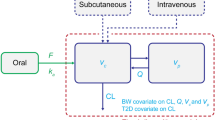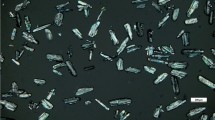Abstract
Zeolite A is a synthetic zeolite which may have therapeutic utility in osteoporotic individuals because of its ability to stimulate bone formation. A study of Zeolite A (30 mg/kg), sodium aluminosilicate (16 mg/kg), magnesium trisilicate (20 mg/kg), and aluminum hydroxide (675 mg) was designed in beagle dogs. The purpose of this study was to compare the oral bioavailability of silicon and aluminum from Zeolite A, sodium aluminosilicate, magnesium trisilicate, and aluminum hydroxide in dogs. Twelve female dogs received each compound as a single dose separated by one week in a randomized, 4-way, crossover design. Plasma samples were drawn at time 0 and for 24 hours after dosing. The concentrations of silicon and aluminum were determined by graphite furnace atomic absorption. The mean plasma silicon AUC values (±S.D.) were 9.5 ± 4.5, 7.7 ± 1.6, 8.8 ± 3.0, 6.1 ± 1.9 mg · hr/L and the mean plasma silicon Cmax values (±S.D.) were 1.07 ± 1.06, 0.67 ± 0.27, 0.75 ± 0.31, 0.44 ± 0.17 mg/L for Zeolite A, sodium aluminosilicate, magnesium trisilicate, and aluminum hydroxide respectively. Although mean silicon AUC and Cmax values were elevated when compared to baseline after administration of the silicon containing compounds, only the AUC from Zeolite A reached statistical significance (p = 0.041). The mean plasma silicon Tmaxvalues (±S.D.) were 7.9 ± 6.4, 5.8 ± 4.6, 6.9 ± 6.3 and 8.5 ± 3.4 hrs for Zeolite A, sodium aluminosilicate, magnesium trisilicate and aluminum hydroxide respectively. These values were not statistically different. The mean plasma aluminum AUC values for Zeolite A, sodium aluminosilicate, magnesium trisilicate and aluminum hydroxide (±S.D.) were 342 ± 111, 338 ± 167, 315 ± 69, 355 ± 150 µg · hr/L and the mean aluminum Cmax values (±S.D.) were 29 ± 9, 27 ± 14, 24 ± 5 µg/L, 29 ± 11 respectively. The plasma aluminum Tmax values (±S.D.) were 3.5 ± 4.1, 4.2 ± 4.3, 5.7 ± 7.3 and 5.0 ± 4.7 hrs for Zeolite A, sodium aluminosilicate, magnesium trisilicate, and aluminum hydroxide respectively. There was no statistically significant absorption of aluminum from the aluminum containing treatments.
Similar content being viewed by others
REFERENCES
E. M. Carlisle. Silicon: A possible factor in bone calcification. Science 167:279–280 (1970).
E. M. Carlisle. A silicon requirement for normal skull formation in chicks. J. Nutr. 110:352–359 (1980).
J. Eisinger, D. Clairet. Effects of silicon, fluoride, etidronate and magnesium on bone mineral density: a retrospective study. Magnesium Research 6(3):247–249 (1993).
E. M. Carlisle. Silicon in bone formation. In T. L. Simpson, B. E. Volcani, (eds.) Silicon and Siliceous Structures in Biological Systems; Springer-Verlag, New York, 1981, pp 69–94.
P. E. Keeting, M. J. Oursler, K. E. Weigand, S. K. Bonde, T. C. Spelsberg, B. L. Riggs. Zeolite A increases proliferation, differentiation and TGF-β production in normal adult human osteoblast-like cells in vitro. J. Bone Min. Res. 7:1281–1289 (1992).
R. M. Leach Jr., B. S. Heinrichs, J. Burdette. Broiler chicks fed low calcium diets. 1. Influence of Zeolite on growth rate and parameters of bone metabolism. J. Poul. Sci. 69:1539–1543 (1990).
J. L. Greger. Dietary and other sources of aluminum intake. Ciba Found. Symp. 169:26–49 (1992).
E. A. Cefali, J. C. Nolan, W. R. McConnell, D. Lowe Walters. Bioavailability of Silicon and Aluminum from Zeolite A in Dogs. Submitted to Int. Journ. Pharm. Apr. 1994.
H. J. Gitelman, F. R. Alderman. Electrothermal determination of silicon in biological samples by atomic absorption spectroscopy. J. Anal. Atomic. Spectrometry 5:687–689 (1990).
H. J. Gitelman, F. R. Alderman. Electrothermal atomic absorption spectrometric determination of aluminum: elimination of serum matrix effects. Clin. Chem. 35:1517–1519 (1989).
C. Schlatter. Biomedical aspects of aluminum. Med. La. 83(5):470–474 (1992).
A. Lione. Aluminum intake from non-prescription drugs and sulcralfate. Gen. Pharmacol. 16:223–228 (1985).
R. Weberg, A. Berstad. Gastrointestinal absorption of aluminum from single doses of aluminum containing antacids in man. Euro J. Clin. Invest. 16:428–432 (1986).
Author information
Authors and Affiliations
Rights and permissions
About this article
Cite this article
Cefali, E.A., Nolan, J.C., McConnell, W.R. et al. Pharmacokinetic Study of Zeolite A, Sodium Aluminosilicate, Magnesium Silicate, and Aluminum Hydroxide in Dogs. Pharm Res 12, 270–274 (1995). https://doi.org/10.1023/A:1016291228957
Issue Date:
DOI: https://doi.org/10.1023/A:1016291228957




